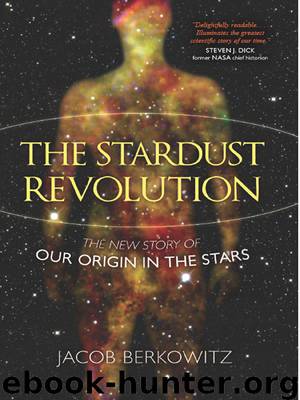The Stardust Revolution by Jacob Berkowitz

Author:Jacob Berkowitz
Language: eng
Format: epub
Publisher: Prometheus Books
Would you rather look at stars through a telescope or hold stardust in your hands?
—Richard Herd, curator of the
Canadian Meteorite Collection, 2011
THE SPACE-ROCK EDUCATION OF SCOTT SANDFORD
In astrobiologist Scott Sandford's cluttered office at NASA's Ames Research Center, twenty-five miles south of San Francisco, the walls are festooned with pictures of his scientific adventures. Some show him bundled up in a heavy parka during one of his Antarctic expeditions in search of meteorites. In his three-decade career, Sandford has stooped down to pick up pieces of the Moon—he found one of the largest lunar meteorites ever, MacAlpine Hills 88105—and was part of the team that from Antarctic ice retrieved a dark meteorite, Allan Hills 84001, identified as a long-traveling piece of Mars that some would later claim contained ancient fossilized Martian microbes. Yet for all this meteoritic success, Sandford is not in the picture of which he's proudest. He couldn't be. It's a simple black-and-white image of what look like tiny grains of sand—which is what they are, except that they were formed in our Solar System's nascent protostellar cloud more than 4.5 billion years ago, long before the existence of Cancun, Cape Cod, or any other terrestrial beach.
The grains were collected by NASA's Stardust mission, launched in 1999, for which Sandford was a leading member of the scientific team. Stardust was the beginning of a dramatically new kind of Solar System prospecting: collecting samples from their source. Rather than wait for asteroidal samples of the Solar System to arrive on Earth as meteorites, Stardust was sent out to sample a comet in its natural habitat—the first space probe to do so. By 2004, Stardust had caught up with comet Wild 2 at about Mars's distance from the Sun, where the probe sped to within one hundred and fifty miles of the two-and-a-half-mile-wide nucleus of the comet—close enough to pass through the comet's coma, the fuzzy halo of dust and ice ejected, geyser-like, from the comet's icy core as it approached the Sun. There, Stardust's aerogel collector—made of a material as light as air yet rigid and strong enough to stop microscopic comet shrapnel—swept up some of this microscopic cometary debris. In 2006, after an almost three-billion-mile round trip, the little explorer dropped off its extraterrestrial cargo in the Utah desert in a special return capsule.
Sandford was among the ecstatic scientists waiting there. After months of microscopic analysis, the Stardust team extracted thousands of tiny cometary particles, all in all less than a milligram of cometary material, weighing less than a grain of table salt. That might seem like a poor return for more than a decade of planning and a $200 million mission to bring back the first samples from beyond the Moon. But Sandford and the other Stardust scientists knew that size didn't really matter. These tiny grains held secrets to a much, much larger story, one that encompassed the entire origin of our Solar System, us included, in the stars.
What's all the more remarkable is that Sandford didn't set out on a career to study the stars.
Download
This site does not store any files on its server. We only index and link to content provided by other sites. Please contact the content providers to delete copyright contents if any and email us, we'll remove relevant links or contents immediately.
| Aeronautics & Astronautics | Astronomy |
| Astrophysics & Space Science | Comets, Meteors & Asteroids |
| Cosmology | Mars |
| Solar System | Star-Gazing |
| Telescopes | UFOs |
Tools of Titans by Timothy Ferriss(8304)
Turbulence by E. J. Noyes(7977)
Secrets of Antigravity Propulsion: Tesla, UFOs, and Classified Aerospace Technology by Ph.D. Paul A. Laviolette(5332)
Astrophysics for People in a Hurry by Neil DeGrasse Tyson(5151)
Room 212 by Kate Stewart(5070)
Design of Trajectory Optimization Approach for Space Maneuver Vehicle Skip Entry Problems by Runqi Chai & Al Savvaris & Antonios Tsourdos & Senchun Chai(5037)
Pale Blue Dot by Carl Sagan(4953)
The David Icke Guide to the Global Conspiracy (and how to end it) by David Icke(4655)
A Journey Through Divination and Astronomy by Publishing Pottermore(4363)
Goodbye Paradise(3761)
Apollo 8 by Jeffrey Kluger(3667)
COSMOS by Carl Sagan(3588)
The Five People You Meet in Heaven by Mitch Albom(3520)
Losing the Nobel Prize by Brian Keating(3518)
How to Read Water: Clues and Patterns from Puddles to the Sea (Natural Navigation) by Tristan Gooley(3431)
Brief Answers to the Big Questions by Stephen Hawking(3392)
How to Read Nature by Tristan Gooley(3290)
The Order of Time by Carlo Rovelli(3162)
A Brief History of Time by Stephen Hawking(2991)
